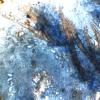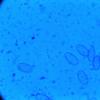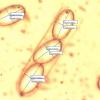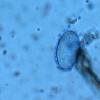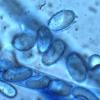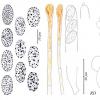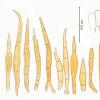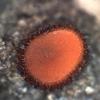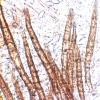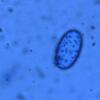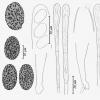
26-12-2025 21:19
Arnold BüschlenPithyella challaudii Pirou. Ist als Bryoparasit in

21-12-2025 09:32
Hello.A tiny ascomycete found embedded in wood in

24-12-2025 17:08
Hulda Caroline HolteHello, I have found this propoloid ascomycete on

21-12-2025 21:32
Pol DebaenstHello, Garden, Burgweg 19, Veurne, BelgiumOn 10/1

22-12-2025 23:38
Patrice TANCHAUDBonsoir, récolte sur un mur en pierre, apothéci
Scutellinia minutella?
Malcolm Greaves,
11-07-2016 23:56
Not even sure if this was the same species but it was collected alongside the "Strange Paraphyses"
specimen. This had a slightly convex surface but looked to have even shorter hairs so I thought it might be more mature and give better spores.
It did! The spores averaged 16 x 8.5 with small sometimes converging warts. This time I managed to heat in cotton blue and found the hoped for reaction and the outer layer came away from the spore.
Is this likely to be S minutella.
Thanks
Mal
René Dougoud,
12-07-2016 11:06
Re : Scutellinia minutella?
Cher Collègue,
La qualité de vos photos ne me permets pas de faire de bonnes observations. Aussi, je vous remets, en dossiers attachés, mes dessins de S minutella qui vous permettrons des comparaisons avec votre récolte. Il faut savoir que chez S. minutella, les poils sont jaunes et assez souvent obtus.
Il y a encore deux espèces assez proches de S. minutella, soit S. torrentis (mais les ascospores sont plus larges que celles que vous avez mesurées) et S. parvispora, espèce non encore publiée (Benat).
Cordialement
René
La qualité de vos photos ne me permets pas de faire de bonnes observations. Aussi, je vous remets, en dossiers attachés, mes dessins de S minutella qui vous permettrons des comparaisons avec votre récolte. Il faut savoir que chez S. minutella, les poils sont jaunes et assez souvent obtus.
Il y a encore deux espèces assez proches de S. minutella, soit S. torrentis (mais les ascospores sont plus larges que celles que vous avez mesurées) et S. parvispora, espèce non encore publiée (Benat).
Cordialement
René
Malcolm Greaves,
12-07-2016 13:37
Re : Scutellinia minutella?
René
Thanks for that. I can see hairs matching most of your sketches and the spores are small enough to be a good match so I am happy with S minutella. I chose that particular specimen out of the few that were on the same patch of mud because it looked to have a convex surface which which I took for it being more mature but I see is mentioned in the Schumacher description for minutella. There was only one spcimen which I have now dried for preservation and I am loathed to risk ending up with no material for others to check further.
My next problem is that the other apothecia looked to have slightly longer hairs and did not develop the convex profile. The spores were (12.9)14.9(16.47) x (8.17) 8.8(9.54). The hairs were not as contorted and did not have any with the rounded ends of the first specimen. Taking samples from them they are a much better fit for S torrentis. Could these two species grow within a few cm of each other or are they likely to be the same just showing a degree of variation?
Mal
Thanks for that. I can see hairs matching most of your sketches and the spores are small enough to be a good match so I am happy with S minutella. I chose that particular specimen out of the few that were on the same patch of mud because it looked to have a convex surface which which I took for it being more mature but I see is mentioned in the Schumacher description for minutella. There was only one spcimen which I have now dried for preservation and I am loathed to risk ending up with no material for others to check further.
My next problem is that the other apothecia looked to have slightly longer hairs and did not develop the convex profile. The spores were (12.9)14.9(16.47) x (8.17) 8.8(9.54). The hairs were not as contorted and did not have any with the rounded ends of the first specimen. Taking samples from them they are a much better fit for S torrentis. Could these two species grow within a few cm of each other or are they likely to be the same just showing a degree of variation?
Mal
René Dougoud,
12-07-2016 15:35
Viktorie Halasu,
13-07-2016 15:36

Re : Scutellinia minutella?
Mr. Greaves & Dougoud,
I'd like to ask - how reliable is this character, that certain species have convex apothecium? I don't have much experience with Scutellinias yet, so I thought that almost any species with small apothecia (about 2 mm diam.) could have convex apothecia in a humid enough environment. I've seen it with e.g. Miladina lecithina or Hymenoscyphus fraxineus growing on water-soaked wood. Or is it rather an ecological indicator, meaning that S. minutella likes more humid places than some other small Scutellinia sp. (but if found elsewhere, the apo would be flat too)?
I'd like to ask - how reliable is this character, that certain species have convex apothecium? I don't have much experience with Scutellinias yet, so I thought that almost any species with small apothecia (about 2 mm diam.) could have convex apothecia in a humid enough environment. I've seen it with e.g. Miladina lecithina or Hymenoscyphus fraxineus growing on water-soaked wood. Or is it rather an ecological indicator, meaning that S. minutella likes more humid places than some other small Scutellinia sp. (but if found elsewhere, the apo would be flat too)?
René Dougoud,
13-07-2016 17:08
Re : Scutellinia minutella?
Cher Collègue,
Le plus souvent, la forme convexe des apothécies résulte de la maturié, y compris les déchirement de la marge. J'explique ce phénomène dans ma publication "Contributiion à l'étude des discomycètes" version 2013, on lin sur le site Ascomycete.org
René
Voici ce que je dis:
L'apothécie et susceptible de modifier sa morphologie, son aspect
général, en cours de croissance. Cette évolution morphologique
fait généralement l'objet d'une description. On trouvera, par
exemple : « Apothécie hémisphérique à l'état jeune, puis cupuliforme
à étalée ... ». En effet et hormis sa dimension, la forme de
l'apothécie varie généralement au cours de la croissance. Cette évolution
progressive de forme est surtout remarquable sur des espèces
cupulées ou plus ou moins planes, portées ou non par un pied. Mais
elle concerne aussi, et pour les mêmes motifs, avec cependant des
conséquences un peu distinctes, mais faciles à extrapoler, d'autres
formes d'ascomes, à l'image de celle selliforme du genre Helvella L.
En se développant, l'apothécie à une tendance à s'ouvrir, à évoluer
de la forme concave à étalée, à convexe, ou de la forme plane vers
celle convexe, avec parfois même des déformations de l'apothécie,
qui devient ondulée à lobée. Mais pourquoi cette évolution ? Elle
est surtout liée aux importantes différences de structures cellulaires
et de modes de croissances existant entre la chair d'une part et l'hyménium
d'autre part. Si la chair qui supporte l'hyménium peut
continuer de croître, elle devient à un certain moment moins rapide
que celle de l'hyménium, des asques en particulier. Ceux-ci d'abords
absents, deviennent de plus en plus nombreux et à la fois de plus en
plus longs et volumineux à mesure de leur maturité. Ils exercent
alors une force centrifuge sur le réceptacle qui, de ce fait, aboutit à
une évolution plus ou moins marquée de la forme de l'apothécie.
Le plus souvent, la forme convexe des apothécies résulte de la maturié, y compris les déchirement de la marge. J'explique ce phénomène dans ma publication "Contributiion à l'étude des discomycètes" version 2013, on lin sur le site Ascomycete.org
René
Voici ce que je dis:
L'apothécie et susceptible de modifier sa morphologie, son aspect
général, en cours de croissance. Cette évolution morphologique
fait généralement l'objet d'une description. On trouvera, par
exemple : « Apothécie hémisphérique à l'état jeune, puis cupuliforme
à étalée ... ». En effet et hormis sa dimension, la forme de
l'apothécie varie généralement au cours de la croissance. Cette évolution
progressive de forme est surtout remarquable sur des espèces
cupulées ou plus ou moins planes, portées ou non par un pied. Mais
elle concerne aussi, et pour les mêmes motifs, avec cependant des
conséquences un peu distinctes, mais faciles à extrapoler, d'autres
formes d'ascomes, à l'image de celle selliforme du genre Helvella L.
En se développant, l'apothécie à une tendance à s'ouvrir, à évoluer
de la forme concave à étalée, à convexe, ou de la forme plane vers
celle convexe, avec parfois même des déformations de l'apothécie,
qui devient ondulée à lobée. Mais pourquoi cette évolution ? Elle
est surtout liée aux importantes différences de structures cellulaires
et de modes de croissances existant entre la chair d'une part et l'hyménium
d'autre part. Si la chair qui supporte l'hyménium peut
continuer de croître, elle devient à un certain moment moins rapide
que celle de l'hyménium, des asques en particulier. Ceux-ci d'abords
absents, deviennent de plus en plus nombreux et à la fois de plus en
plus longs et volumineux à mesure de leur maturité. Ils exercent
alors une force centrifuge sur le réceptacle qui, de ce fait, aboutit à
une évolution plus ou moins marquée de la forme de l'apothécie.
Malcolm Greaves,
13-07-2016 20:14
Re : Scutellinia minutella?
Thanks for that information René.
Of all the apothecia that I found there was only the one with the convex hymenium and the rest were the more normal depressed shape and I assumed that it was like that because it was more mature than the rest. I spotted that Schumacher mentioned this as one of the features used in splitting S torrentis (S convexa) and S minutella although I attributed it to the latter rather than the former. As far as I can see it is not mentioned in connection with any other species in the study. The only other species I have noticed this feature in is S heterosphaera.
Mal
Of all the apothecia that I found there was only the one with the convex hymenium and the rest were the more normal depressed shape and I assumed that it was like that because it was more mature than the rest. I spotted that Schumacher mentioned this as one of the features used in splitting S torrentis (S convexa) and S minutella although I attributed it to the latter rather than the former. As far as I can see it is not mentioned in connection with any other species in the study. The only other species I have noticed this feature in is S heterosphaera.
Mal

